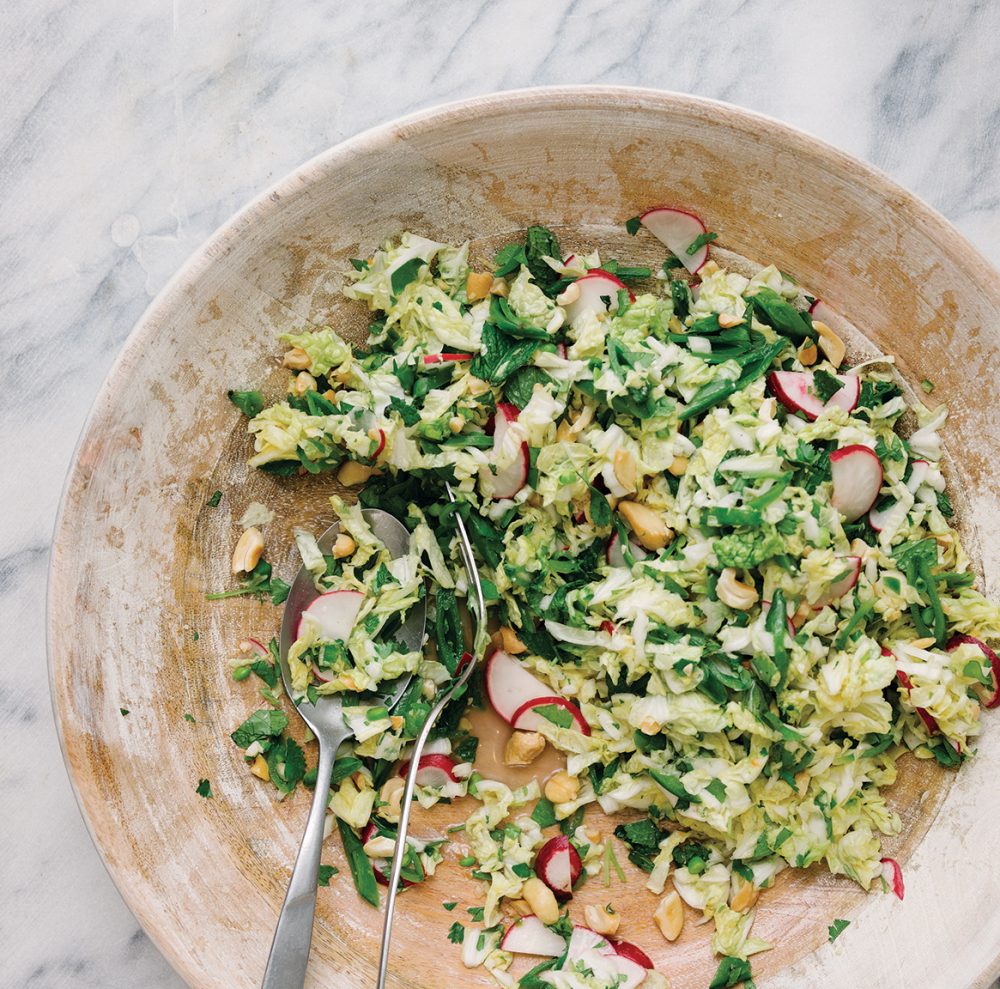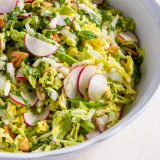When it comes to coleslaw, the U.S. got a raw deal. Most of the world enjoys a delicious abundance of slaws boasting bright, bold flavors, contrasting textures and affinities for rich, fatty foods.
In Germany, there are slaws with apples and onions dressed with oil and vinegar. In China, there is broccoli with ginger and soy. In Thailand, it’s papaya. In Japan, cabbage is salted and pressed, then splashed with plum vinegar.
But here? We get a mush of shredded cabbage slopped in mayonnaise. It sits uneaten on the edge of paper plates, most of it destined for the trash. How did we end up in this mess?
The coupling of cabbage and mayonnaise in America goes back a couple centuries, but the origins of the pairing are obscured. Mayonnaise itself dates back at least to the mid-18th century, though whether it was created by the French or the Spanish is much debated. And possibly they both deserve credit, as mayonnaise’s mother—garlicky aioli—has been common in both countries since Roman times. Mayonnaise began showing up in American cookbooks by 1829 and was a common condiment for salads and meat by 1880.
Coleslaw as we know it here traces its birth to roughly the same period and likely began as the Dutch salad koolsla (kool meaning cabbage, sla meaning salad), a mixture of thinly sliced cabbage, vinegar, oil (or melted butter) and seasonings. Mayonnaise likely didn’t show up as a common ingredient in coleslaw until the rise of packaged foods.
By the 1920s, there were hundreds of mayonnaise brands around the country. It was a surge that, not coincidentally, paralleled the rising popularity of mayo-based coleslaw. Today, roughly 45 percent of all cabbage in the U.S. is destined for coleslaw, most of it commercially produced and—as we all know—headed for the trash. And that’s a shame. Because a good slaw is the ideal accompaniment to grilled meats, its acidic dressing cutting through the richness, its cool crunch adding a wonderful contrast.
There are, of course, some great exceptions to mayo slaws. Some of the better Texas barbecue joints understand the importance of the right slaw, building them with layers of flavor, not one-note mayonnaise.

Coleslaws with bright acidic flavors beg to be paired with rich, savory meats. Mayonnaise would only bog things down.
“Those slaws bear the imprint of Germanic techniques,” Melanie Haupt, a Texas barbecue specialist and historian, says of koolsla-style slaws. “You’ve got a fine shred, and mayonnaise has not come within a country mile of it. It’s vinegar-based. It’s probably got a little bit of cumin. It’s going to have celery seed, maybe some caraway seeds or sesame seeds.”
Which brought us and our search for a better slaw to San Antonio chef Quealy Watson, whose cooking was changed when he traveled to Asia. In Japan, he was impressed by a clean, simple heap of sweet, crunchy cabbage served alongside sliced deep-fried pork (tonkatsu).
It felt as familiar as the coleslaws from home, but with flavors far more compatible. In Bangkok, he hesitated a bit before digging into a bowl of som tum, unsure of what to make of the poo naa—tiny rice paddy crabs that add crunch to the papaya slaw.
He brought these and other ideas back to Hot Joy, the funky Tex-Asian barbecue joint where Watson was chef at the time. He’d already been drawing together East-West flavors, knowing small tweaks could overhaul classics. His smoked-brisket dandan noodles, for example, or his crab-fat caramel chicken wings.
Coleslaw would be no exception.
Watson’s Tex-Asian slaw draws inspiration (and fragrant depth) from traditional Burmese lahpet, a style of fermented or pickled tea leaves often eaten as salad. The leaves add a sour-spicy crunch to the crisp savoy cabbage, all of it dressed with shallots, garlic and lime juice. Suddenly a boring bowl of cabbage has bright flavors, tart acid and a satisfying crunch.
Balance is key. In our Thai-style slaw, we contrast tender-crisp napa cabbage with crunchy-creamy cashews, while lime juice and fish sauce play off the coconut milk.
“Mayonnaise just gets in the way,” he says. “It makes more sense to go really bright with it, and that always leads my mind to Thai food—lots of lime and some heat. Lots of herbs and acidity.”
We liked Watson’s use of Asian flavors and wanted a similarly hybridized slaw. We started by ditching green or red cabbage in favor of tenderer napa cabbage, which has a slightly mustardy flavor.
For the fat, we tried returning to the oil favored in koolsla but found it made the cabbage greasy. With Watson’s Tex-Asian sensibilities in mind, we settled on coconut milk, which has a mayonnaise-like richness but better flavor that paired well with other Asian ingredients.
Fish sauce was a must; it lent deep savory flavors without the fishiness. So was a serrano chili, which packed just the right heat. To keep both those flavors in balance, we added a fair helping of sugar, which also brought the slaw a little closer to what Americans expect.
We considered carrots, as they are traditional in classic American coleslaw, but found them too crunchy. Red radishes and sugar snap peas were just right. And bringing it all together was a mix of fresh mint and cilantro, a combination found across Southeast Asian cuisines.
By the time we were done, we had a coleslaw that not only paired perfectly with all-American barbecue but also wouldn’t languish on the side of the plate, awaiting a fate in the trash.




